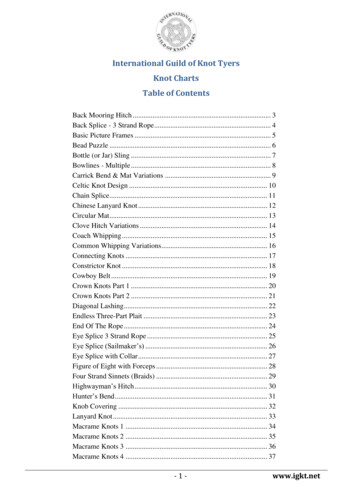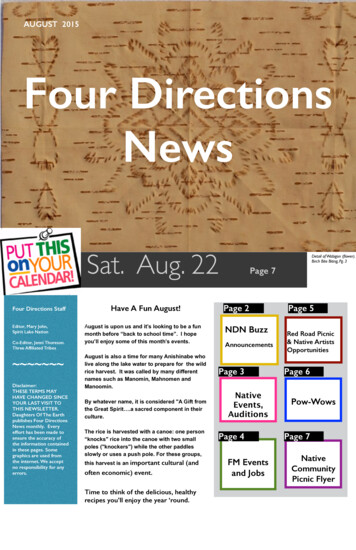![BCA160 Macrame [2015] - NDSU](/img/19/bca160.jpg)
Transcription
BCA160MacrameKnots and ProjectsMacrame is a creative art that can inspire nearlyanyone who enjoys doing handwork.Macrame is done by making patterns of knotswith materials such as string, twine or cord.The combination of colored cords and the added beads, ringsand attachments is what makes macrame an art.Reviewed bySharon Query4-H Youth Development SpecialistNDSU Extension ServiceApril 2015www.ndsu.edu/4h 1
ObjectivesIntermediate and Advanced Learn to tie basic macrame knots(intermediate, three to four years in project;advanced, five or more years in project) Create macrame works of artSuggested ProjectRequirementsThese are the minimum suggested requirements forbeginning, intermediate and advanced levels of thisproject. Use the 4-H Project Plan (PA095) to recordeach activity as it is completed.Beginner1. Learn two additional macrame knots or techniqueseach year you take the project. Incorporate theseknots or techniques into an article you make.2. Make two or more macrame articles that are achallenge to you and help you perfect yournew skills.Intermediate projects:– Collar– Candle cradle– Purse(two years or less in project)– Wall hanging1. Visit a resource person or local craft shop to obtainsupplies needed for a basic macrame project.You also can obtain supplies and project ideasthrough the Internet and by mail.– Belt2. Learn to tie four basic macrame knots(lark’s head, square, half-hitch and half-knot).3. Make three simple macrame articles, such as thosesuggested below. Two projects should be madefrom instructions given in this project publication.– Mouse or small animal(sample pattern included)– Necklace (sample pattern included)– Belt(sample pattern included)– Bracelet– Simple plant hanger using two to three knots(sample pattern included)– Wall hanging– Place mat4. Prepare and give at least one demonstrationon something you have learned in the project.– Pillow– Place mat– Animals– Plant hanger– Project of your choiceAdvanced projects:– Large wall hanging– Lamp shade– Window treatment– Hanging shelf– Hanging table– Lawn chair– Hammock– Project of your choice3. Visit a local resource person or library to locateresources for intermediate and advanced macramework. No advanced instructions are given in thisproject publication. Remember the Internet as aresource site.4. Prepare and give at least one demonstration onsomething you have learned in this project.5. If your club situation allows, assist one or morebeginners with the macrame project.2 BCA160 Macrame Knots and Projects
Working SurfaceThe working surface you use depends on the sizeof your project. If you choose to do a large hanging,supporting your project on hooks on pegboard mightbe easiest. This method will enable you to move yourhanging higher more easily as you work, or lower it asyou sit down. If you are going to macrame a smallerobject such as a belt or necklace, a mounting boardwill aid you in securing your project while you work.For learning to tie knots, select a mounting boardthat is at least 12 inches high and 6 inches wide.A mounting board canbe made from a pieceof heavy cardboard,a discarded fabricbolt, a small bulletinboard or a ceiling tile.The mounting boardwill help you keep thesize of knots and thepattern uniform.When planning amacrame project,choose a mountingMOUNTING BOARDboard of appropriatesize for your pattern.To help keep your patterneven, draw lines on the mounting board in 1-inchsquares or use contact paper with 1-inch squares.MaterialsKnotting is worked from a holding cord ormounting stick. The holding cord can be cord,but it also could be sticks, rings, driftwood,belt buckles, etc. – anything that is appropriatefor your project. These items are used to mountthe project and begin the knotting process.cotton and sisal. Cotton rug yarn does not give asnice an effect as other materials, but it provides aninexpensive practice material for the beginner.Determining what yarns and cords are like bylooking at pictures or reading descriptions is difficult,so experiment with different cords while you learnbasic macrame techniques. Project instructions oftentell you the type and amount of cord needed.You also will need pins (such as corsage pins, T-pinsor push pins), rubber bands, a ruler and scissors.Preparation for KnottingTo tie anoverhand knot:1. The first step isto determine thefinished lengthof the project.For practicepurposes,your finishedlength willbe 12 inches.OVERHAND KNOT2. Cut four cords four times the finished length ofyour project – 48 inches.3. The cord must bemounted on a holdingTip:cord or some otherIf you are a beginner,object. As youusing different colors of cord,or painting the ends differentlearn to tie knots,colors with permanent markersuse a holding cordor nail polish will be lessmade by cutting aconfusing while learningto tie knots.10-inch length andtie an overhandknot in each end.a. Make a loop with your cord. Bring the endof your cord down through the loop.b. Pull both ends tightly to complete the knot.Almost any kind of cord that has a little body andis moderately stiff can be used. Jute is one of thematerials that shows the knots best and is easy toobtain. Other materials often used in macrame are4. Use a corsage pin or a T-pin to pin the cordsecurely to your mounting board.www.ndsu.edu/4h 3
Attach the Knotting Cords1. Fold eachof your48-inchlengthsof cordin halfas shown.b. When the bundle is complete, secure it with arubber band in the center where the cords cross.This bundle is called a butterfly. A gentle pullwill release the cord as you need it.You are ready to begin knotting.2. Mount a cord length on the holding cord usinga lark’s head knot.a. Place the center point of the cord over theholding cord to form a loop.b. Pull the cord ends through the loop.c. Pull the cord ends so the knot will be tightagainst the holding cord.Basic KnotsSquare Knot and Half-knotA square knot is made of two half-knots. Usingholding cord and pieces of cord mounted on themounting board, follow the illustrations. Beginwith the first four loose cords on the holding cord.LARK'S HEAD KNOT3. Mount the other three cords the same way.4. Make working with the cords easier by makinga butterfly.a. With the palm ofyour hand facing you,put the cord betweenyour index and thirdfingers. With the knotand one end of theBUTTERFLYcord to the back ofyour hand, windthe front cord aroundthe thumb between thering and little finger andback to the thumb in a figure-8 motion.4 BCA160 Macrame Knots and Projectsa. Take the left outside (knotting) cord andplace it over the two center (knot-bearing)cords in an L shape. Place cord 4 over thetop of cord 1 at the end of the L.b. Now bring the right outside cord (4) undercords 2 and 3. Pull cord 4 up through thehole between cords 1 and 2. You will havea half-knot, or the first half of a square knot.
Alternating Square KnotsTip:To tie an alternating square knot pattern, useeight cords.When tying macrame knots,tie every knot closely againstthe previous knot unlessyour instructionssay otherwise.a. Tie one square knot with each group offour cords, one knot alongside the other.c. To finish the square knot, bring cord 1 backover cords 3 and 2. Place cord 4 over thetop of cord 1.d. Now bring cord 4 under cords 2 and 3.Pull cord 4 up through the hole betweencords 3 and 1. Pull your knot-bearing cordsup tightly against the first half of the knot.You have a completed square knot.b. Tie a second row of square knots using thefollowing four cords: 3 and 4 from thesquare knot on the left side, and 1 and 2 fromthe square knot on the right side.Tie another square knot using 4 and 1 for theknot-bearing cords, and 2 and 3 for the knottingcords. This square knot should join the cordsbelow your two square knots in the top row.To avoid a lopsided knot, be sure to put an equalamount of tension on the knot-bearing cordswhen pulling knots into place.HALF KNOTALTERNATING SQUARE KNOTSSQUARE KNOTwww.ndsu.edu/4h 5
Half-hitch KnotJosephine KnotA half-hitch knot creates a raised riblike design.It can be tied from the right or the left to achieve thedesired effect. A half-hitch is done with two cords:a knotting cord (1) and a knot-bearing cord (2).Always lay the knotting cord across the top of theknot-bearing cord. Then loop cord 1 behind cord 2and down through the loop. Pull up on knot-bearingcord until desired tension is achieved.Fold the cord in half lengthwise. Make a loop,bringing the left cord under the right cord, thenunder the first loop to form a lower loop. (Figure a.)Loop right cord under loose left cord, and weave overleft, under center, over right and under lower loop,as illustrated in Figure b.JOSEPHINE KNOTRows of Half-hitch KnotsHALF HITCH KNOTDouble Half-hitch KnotMake a single half-hitch. Bring cord 1 (gray) upover cord 2 (white) again, then down throughthe loop to complete a double half-hitch.21DOUBLE HALF HITCH KNOT6 BCA160 Macrame Knots and ProjectsVariations of the half-hitch knots are used to makehorizontal, diagonal and vertical rows.Horizontal RowsThis is a row of half-hitches. The illustration showsseven different cordsHORIZONAL HALF HITCHES
DiagonalWrap KnotWhen the instructions call for a diagonal doublehalf-hitch, hold the knot-bearing cord tightly ata downward slant, then tie the knotting cordaround it in double half-hitches.A wrap knot is made by bringing a group of cordstogether and placing the cord used for wrappingover the top of the group of cords to form a loop.Using the same cord you used to make the loop,begin wrapping neatly around and around yourgroup of cords. Almost cover the loop completelyunder the wrapping.When you have wrapped as much as you want,pull the end of the wrapping cord through theloop at the bottom of the wrap.Pull the cord at the top. This will pull the loopand cord up and underneath the wrap. The loopshould be completely hidden underneath the wrap.Trim off the top and bottom cord as closely aspossible to the wrap.DIAGONAL HALF HITCHESVerticalTo tie a vertical double half-hitch, hold theknot-bearing cord in a vertical position, then tiethe knotting cord around it in double half-hitches.VERTICAL HALF HITCHESWRAP KNOTwww.ndsu.edu/4h 7
ProjectsSelect an article that will not be too difficult to make and that you can use.Your first project could be a wall hanging made by completing samples of theknots described in this publication and arranging them on a piece of driftwood. Macrame MouseMaterials 30-inch piece of jute or cord 3-inch piece of jute 2 small movable eyes(optional) Small seed bead(optional) Craft glue Mounting board Ruler Corsage pinWork on a mounting board.1. Find the center of the cord. Place a pin (A) in thecenter of the cord and pin it near the bottom ofthe board.2. Work toward the top of the board. Measure 3 inchesup from pin A and place pin B through both cords3. Fold one cord down each side and cross over thetwo strands between pin A and pin B, formingtwo loops about 1 inch in size.4. Place pins C and D in the tops of the loops to holdthem secure. These loops form the mouse ears.5. Make four square knots between pins B and Awith the cord that was crossed. Pull the knotstightly against pin B.6. The mouse should look like the illustration.8 BCA160 Macrame Knots and Projects7. Take the bottom knot-bearing cord, which formsthe loop under the mouse. Cut if off even withthe last square knot. Dot with glue so it can’tcome loose.8. Cut off one knotting cord even with the last squareknot. Dot with glue. The last cord becomes themouse’s tail.9. You may want to add two eyes, nose and whiskers.Glue on the two movable eyes below the ears. Forthe nose and whiskers; unravel the 3-inch pieceof jute to make single strands. Put several strandsthrough the eye of the seed bead, spread them outto look like whiskers and glue the bead in place. NecklaceSupplies for finished length of:16”19”6 yards6 yards 18 orange “E” beads66 Wooden beads– color choice 1– color choice 23354 Waxed nylon or cotton cord Mounting board T-pins (corsage pins) Scissors Ruler
Basic BeltSupplies 21 yards of number 30 cotton cord 12 beads with holes large enough to pull throughone cord T-pins (corsage pins) Mounting board RulerPreparation:Cut cord into 4 lengths 1½ yards long each1. Tie an overhand knot with all cords and pinto the mounting board.2. Tie 3 inches of regular hair braid. There arefour cords. Hair braid usually is tied with three.Place the extra cord in with one of the other cords.3. Tie five square knots using two knotting cordsand two knot-bearing cords.4. Pull two knot-bearing cords through aColor 2 bead.5. Repeat step 3 and pull two knot-bearing cordsthrough a Color 1 bead.6. Repeat steps 3 and 4.7. Tie six square knots using two knotting cordsand two knot-bearing cords.8. Pull two knot-bearing cords through a Color 1bead. String three “E’” beads on each knottingcord.9. If the 19½-inch necklace is desired, repeat steps7 and 8 two more times.10. Repeat steps in the following order:7, 4, 5, 3, 4, 3, 2.11. Tie an overhand knot and trim off excess cord.Finished length: 20 inches without tasselPreparation: cut six cords 3½ yards long1. Pin each of the six cords to the mounting board,spacing evenly apart, 13 inches from the endsof the cords. This will become the tassel whenthe belt is complete.2. Number your cords 1 to 6 from left to right.Using cords 2 through 5, tie a square knot usingtwo knotting cords and two knot-bearing cords.3. Separate your cords into two groups: 1 to 3 and4 to 6. Tie one square knot with each group, usingtwo knotting cords and one knot-bearing cord.4. Using cords 2 to 5, tie two square knots usingtwo knotting and two knot-bearing cords.www.ndsu.edu/4h 9
5. Repeat steps 3 and 4 20 more times, or untilthe belt is the length you want it.6. Tie one square knot using groups of cords1 to 3 and 4 to 6 with two knotting cordsand one knot-bearing cord.7. Tie one square knot using cords 2 to 5.8. Measure down 13 inches and cut off all cordsevenly.9. Unpin belt from board and place one bead oneach cord end. Tie an overhand knot under eachbead on both tassels so it will not slide off.2. Gather all cords together under the ring. Using a1-yard piece of cord, tie 1½ inches of wrap knot(described earlier in this publication). Butterflyeach cord once and secure with rubber bands.3. Separate the cords into four groups of four cords.Tie 12½ inches of half knots with each group,using two knotting cords and two knot-bearingcords (half square knot instructions describedearlier in this publication).4. Pull the two knottingcords in each groupthrough a beadand bring thetwo knot-bearingcords to the outside touse as knotting cords.This is done so allof the cords willbe used evenly.5. Tie 2½ inches of half square knots oneach group, using two knotting andtwo knot-bearing cords.6. Pull the two knot-bearing cords in each groupthrough a bead. Plant HangerMaterials 66 yards of polyester cable cord or comparable cord 8 beads of a color that contrasts or blends withthe cord; beads must have a hole large enoughfor two cords to pass through 1 2½-inch solid metal ring Rubber bands RulerFinished length: 5½ feetPreparation:Cut eight cords 8 yards long.Cut two cords 1 yard long for wrapping.1. Pull the eight 8-yard cords exactly halfwaythrough the ring10 BCA160 Macrame Knots and Projects7. Tie 12 inches of half square knots on each group,using two knotting and two knot-bearing cords.8. Now form the cradle – the place on the hangerwhere the pot will sit. Take two cords from eachgroup (see illustration) and, leaving 5 inches of
each end unknotted fromyour last knot, tie threesquare knots with fourcords – two knotting andtwo knot-bearing cords.(Square knot instructionsare given in the first partof this publication.)Repeat this step againwith the three remaininggroups of four cords.9. Gather all the cords 5 inchesbelow the last square knot inyour cradle. Using a 1-yardpiece of cord, wrap knot for2 inches.10. Measure down from thewrap knot 12 inches andcut off all cords evenly.Unravel each cord andbrush cords out nicelywith a hairbrush.Standards1. Incorporate good design principlesthroughout the project.2. Make sure the material used matchesthe intended use of the article.3. Use string or cord with a hard twistfor an article that needs a stiff shape.4. Use more flexible string or cord forairy designs and decorations.5. The knot patterns should be the firstconsideration and should dominateany macrame design. This patternshould be enhanced, not obscured,by the texture, color and shape ofany added materials.6. Make sure the tension throughoutthe article is uniform.7. Fasten cords neatly.8. Articles should have a finished lookand be ready for use.www.ndsu.edu/4h 11
Online Resourceswww.macramesuperstore.com/Macrame books to tmlMacrame me patterns, including chair patternswww.kingskountry.comThis publication was prepared by the former North Dakota 4-H Clothing Committee:Peggy Anderson, Gayle Gette, Merry Green, Cindy Swenson,Rachel Vettern and Sue Wold.Illustrations were created by NDSU staff.Visit North Dakota 4-H on-line at www.ndsu.edu/4hNDSU encourages you to use and share this content, but please do so under the conditions of our Creative Commons license.You may copy, distribute, transmit and adapt this work as long as you give full attribution, don’t use the work for commercial purposesand share your resulting work similarly. For more information, visit www.ag.ndsu.edu/agcomm/creative-commons.North Dakota State University does not discriminate on the basis of age, color, disability, gender expression/identity, genetic information,marital status, national origin, public assistance status, sex, sexual orientation, status as a U.S. veteran, race or religion.Direct inquiries to the Vice President for Equity, Diversity and Global Outreach, 205 Old Main, (701) 231-7708.County Commissions, NDSU and U.S. Department of Agriculture Cooperating.This publication will be made available in alternative formats for people with disabilities upon request, (701) 231-7881.12 BCA160 Macrame Knots and Projects150-9-03; 50-12-08; 100-4-15
when pulling knots into place. Alternating Square Knots To tie an alternating square knot pattern, use eight cords. a. Tie one square knot with each group of four cords, one knot alongside the other. b. Tie a second row of square knots using the following four cords: 3 and










